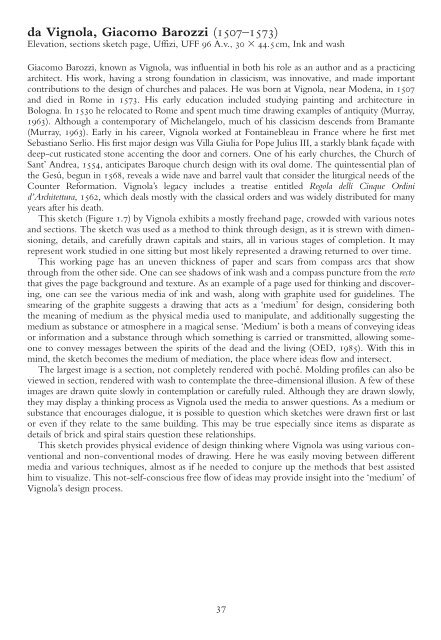Architect Drawings : A Selection of Sketches by World Famous Architects Through History
You also want an ePaper? Increase the reach of your titles
YUMPU automatically turns print PDFs into web optimized ePapers that Google loves.
da Vignola, Giacomo Barozzi (1507–1573)<br />
Elevation, sections sketch page, Uffizi, UFF 96 A.v., 30 44.5cm, Ink and wash<br />
Giacomo Barozzi, known as Vignola, was influential in both his role as an author and as a practicing<br />
architect. His work, having a strong foundation in classicism, was innovative, and made important<br />
contributions to the design <strong>of</strong> churches and palaces. He was born at Vignola, near Modena, in 1507<br />
and died in Rome in 1573. His early education included studying painting and architecture in<br />
Bologna. In 1530 he relocated to Rome and spent much time drawing examples <strong>of</strong> antiquity (Murray,<br />
1963). Although a contemporary <strong>of</strong> Michelangelo, much <strong>of</strong> his classicism descends from Bramante<br />
(Murray, 1963). Early in his career, Vignola worked at Fontainebleau in France where he first met<br />
Sebastiano Serlio. His first major design was Villa Giulia for Pope Julius III, a starkly blank façade with<br />
deep-cut rusticated stone accenting the door and corners. One <strong>of</strong> his early churches, the Church <strong>of</strong><br />
Sant’ Andrea, 1554, anticipates Baroque church design with its oval dome. The quintessential plan <strong>of</strong><br />
the Gesú, begun in 1568, reveals a wide nave and barrel vault that consider the liturgical needs <strong>of</strong> the<br />
Counter Reformation. Vignola’s legacy includes a treatise entitled Regola delli Cinque Ordini<br />
d’Architettura, 1562, which deals mostly with the classical orders and was widely distributed for many<br />
years after his death.<br />
This sketch (Figure 1.7) <strong>by</strong> Vignola exhibits a mostly freehand page, crowded with various notes<br />
and sections. The sketch was used as a method to think through design, as it is strewn with dimensioning,<br />
details, and carefully drawn capitals and stairs, all in various stages <strong>of</strong> completion. It may<br />
represent work studied in one sitting but most likely represented a drawing returned to over time.<br />
This working page has an uneven thickness <strong>of</strong> paper and scars from compass arcs that show<br />
through from the other side. One can see shadows <strong>of</strong> ink wash and a compass puncture from the recto<br />
that gives the page background and texture. As an example <strong>of</strong> a page used for thinking and discovering,<br />
one can see the various media <strong>of</strong> ink and wash, along with graphite used for guidelines. The<br />
smearing <strong>of</strong> the graphite suggests a drawing that acts as a ‘medium’ for design, considering both<br />
the meaning <strong>of</strong> medium as the physical media used to manipulate, and additionally suggesting the<br />
medium as substance or atmosphere in a magical sense. ‘Medium’ is both a means <strong>of</strong> conveying ideas<br />
or information and a substance through which something is carried or transmitted, allowing someone<br />
to convey messages between the spirits <strong>of</strong> the dead and the living (OED, 1985). With this in<br />
mind, the sketch becomes the medium <strong>of</strong> mediation, the place where ideas flow and intersect.<br />
The largest image is a section, not completely rendered with poché. Molding pr<strong>of</strong>iles can also be<br />
viewed in section, rendered with wash to contemplate the three-dimensional illusion. A few <strong>of</strong> these<br />
images are drawn quite slowly in contemplation or carefully ruled. Although they are drawn slowly,<br />
they may display a thinking process as Vignola used the media to answer questions. As a medium or<br />
substance that encourages dialogue, it is possible to question which sketches were drawn first or last<br />
or even if they relate to the same building. This may be true especially since items as disparate as<br />
details <strong>of</strong> brick and spiral stairs question these relationships.<br />
This sketch provides physical evidence <strong>of</strong> design thinking where Vignola was using various conventional<br />
and non-conventional modes <strong>of</strong> drawing. Here he was easily moving between different<br />
media and various techniques, almost as if he needed to conjure up the methods that best assisted<br />
him to visualize. This not-self-conscious free flow <strong>of</strong> ideas may provide insight into the ‘medium’ <strong>of</strong><br />
Vignola’s design process.<br />
37




